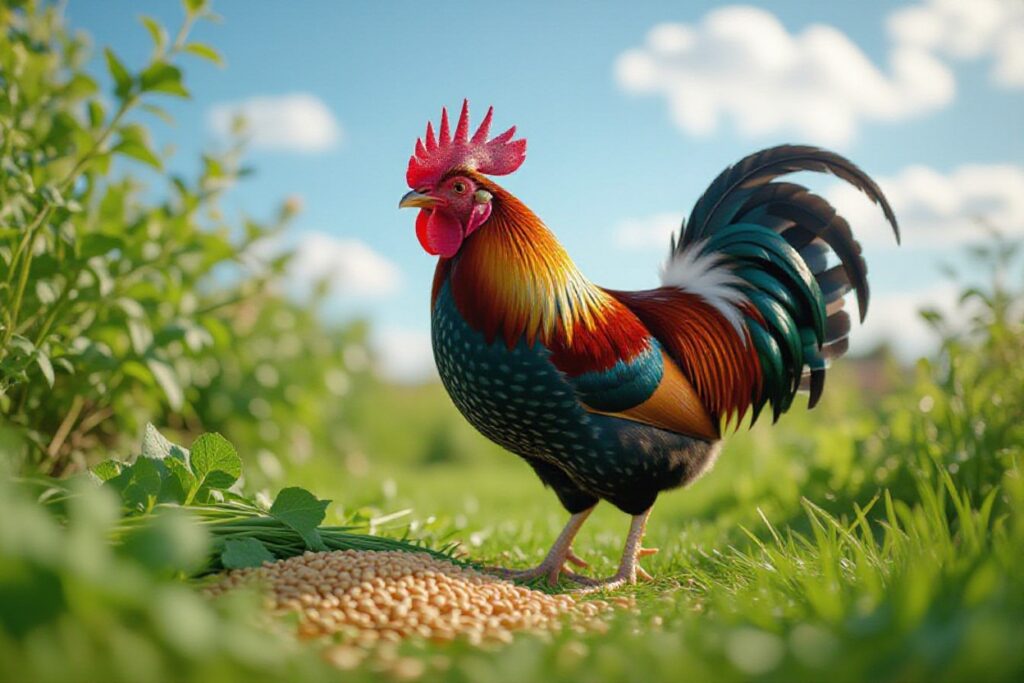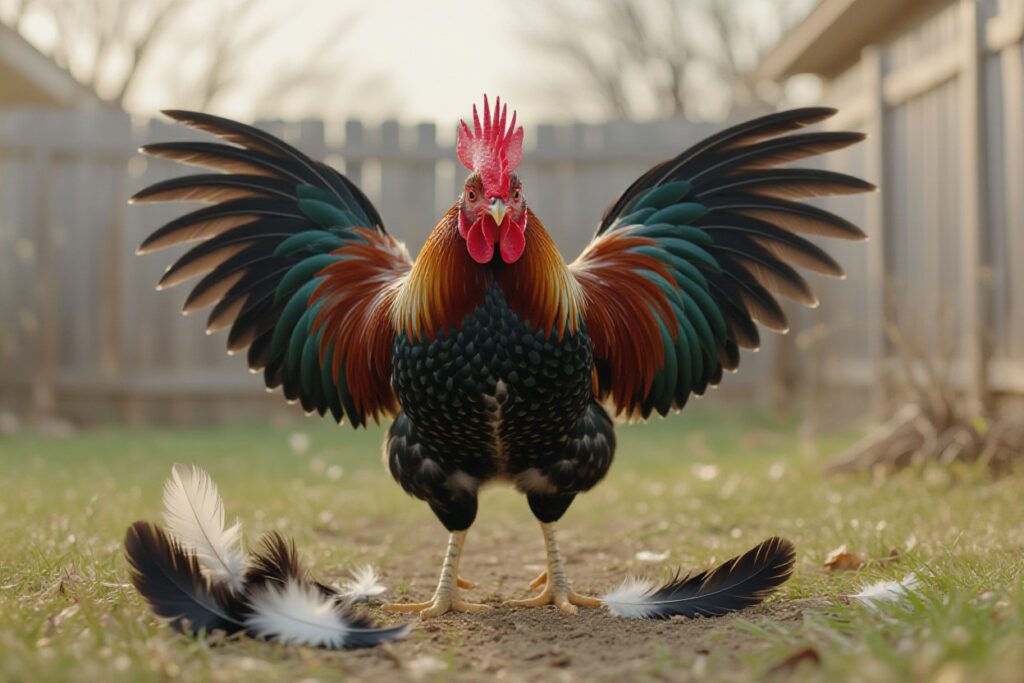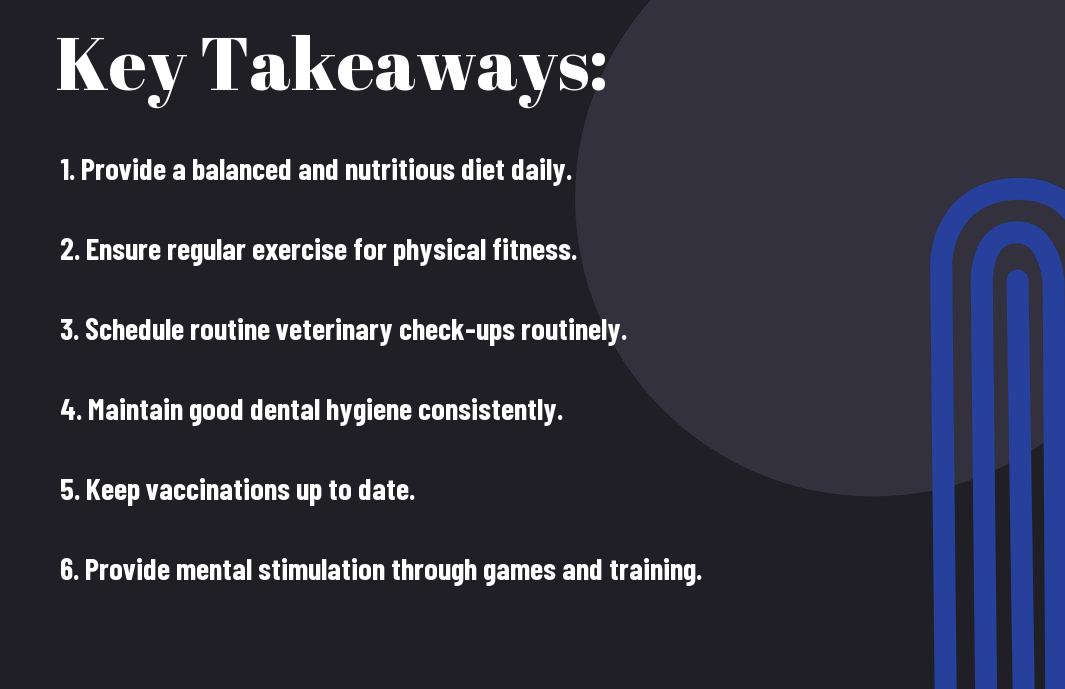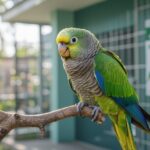Rooster signs of wellbeing include bright, clear eyes, smooth glossy feathers, an alert posture, and a steady appetite; you should watch daily for labored breathing, nasal or ocular discharge, lethargy or rapid weight loss as these are dangerous. You keep a balanced diet, perform regular health checks, monitor behavior and breeding soundness, and seek veterinary care promptly to maintain your healthy rooster.
Signs of Good Health
You should spot a bright red comb and wattles, clear eyes, and smooth, glossy feathers when inspecting a healthy rooster; check daily for steady appetite, normal droppings (firm with white urates), and regular activity. Also note that a stable weight and normal respiration—about 10–30 breaths per minute—are positive signs. Spend 2–3 minutes each morning observing behavior and appearance to catch subtle changes early.
Physical Appearance
Look for a plump, well-proportioned body with no bald patches and feather sheen indicating good nutrition; bantams typically weigh 0.5–1.2 kg, while standard roosters range ~2.5–4.5 kg. Inspect legs for scaly mites, spurs for injury, nostrils for discharge, and the vent for cleanliness; a pale or bluish comb signals anemia or respiratory distress and requires immediate attention.
Behavior and Activity Levels
Expect your rooster to be alert, scratch and forage daily, crow intermittently, and dust-bathe; normal feed intake for many standard roosters is about 70–120 g/day. Social interaction with hens and timely mating displays are positive, whereas lethargy, isolation, or labored breathing are warning signs you should investigate.
Monitor trends: if feed intake falls by >20% or weight drops >5% in a week, take action. Note that molting or older roosters naturally reduce activity, but sudden changes—like decreased crowing, increased aggression, or reluctance to roost—often indicate illness, parasite load, or injury; record daily observations and weigh your rooster weekly to track these shifts.
Daily Health Monitoring
You should inspect your flock at least once, preferably twice, daily to catch changes early; focus on comb color, posture, droppings, appetite and activity. Pay attention to pale or darkened combs, runny eyes/nasal discharge, soft or bloody droppings, and any sudden drop in activity. Logging simple observations—date, weight, comb appearance—lets you spot trends; in practice, a 10% weight loss over a week in a healthy rooster deserves immediate attention.
Observing Rooster Behavior
Watch for normal patterns like regular crowing, foraging, social interaction and dust-bathing; deviations can signal illness. If your rooster isolates, stops crowing, shows reduced mobility or repeated head shaking, or becomes unusually aggressive, those are warning signs. Field example: a keeper noticed reduced foraging and lethargy for three days before finding a parasitic infestation—early behavior spotting let them treat with targeted parasite control and recover the bird.
Routine Health Checks
Perform weekly hands-on checks: open eyes, clear nostrils, smooth feathers, dry vent, solid droppings and firm keel flesh on palpation. Use a 1–5 body condition scale aiming for about 2.5–3 and weigh roosters weekly to track changes. Look under wings for mites, inspect legs for scaly leg mite and check feet for bumblefoot; any labored breathing, swollen joints or persistent diarrhea requires isolation and further evaluation.
When doing a routine exam, follow a consistent sequence: weigh and note comb color, then check eyes/nares for discharge, palpate crop and keel, part feathers to search for lice/mites, inspect vent for blood or soiling and run your fingers along legs/feet for swelling or scabs. Expect a healthy rooster’s crop to empty between about 8–12 hours after feeding; delayed emptying or a soggy crop suggests sour crop or obstruction. Keep a simple log—weight, comb score, behavior notes—and act on trends: >10% weight loss in 7 days, persistent respiratory signs beyond 48 hours, or bloody droppings should prompt veterinary consultation and immediate isolation of the affected bird.
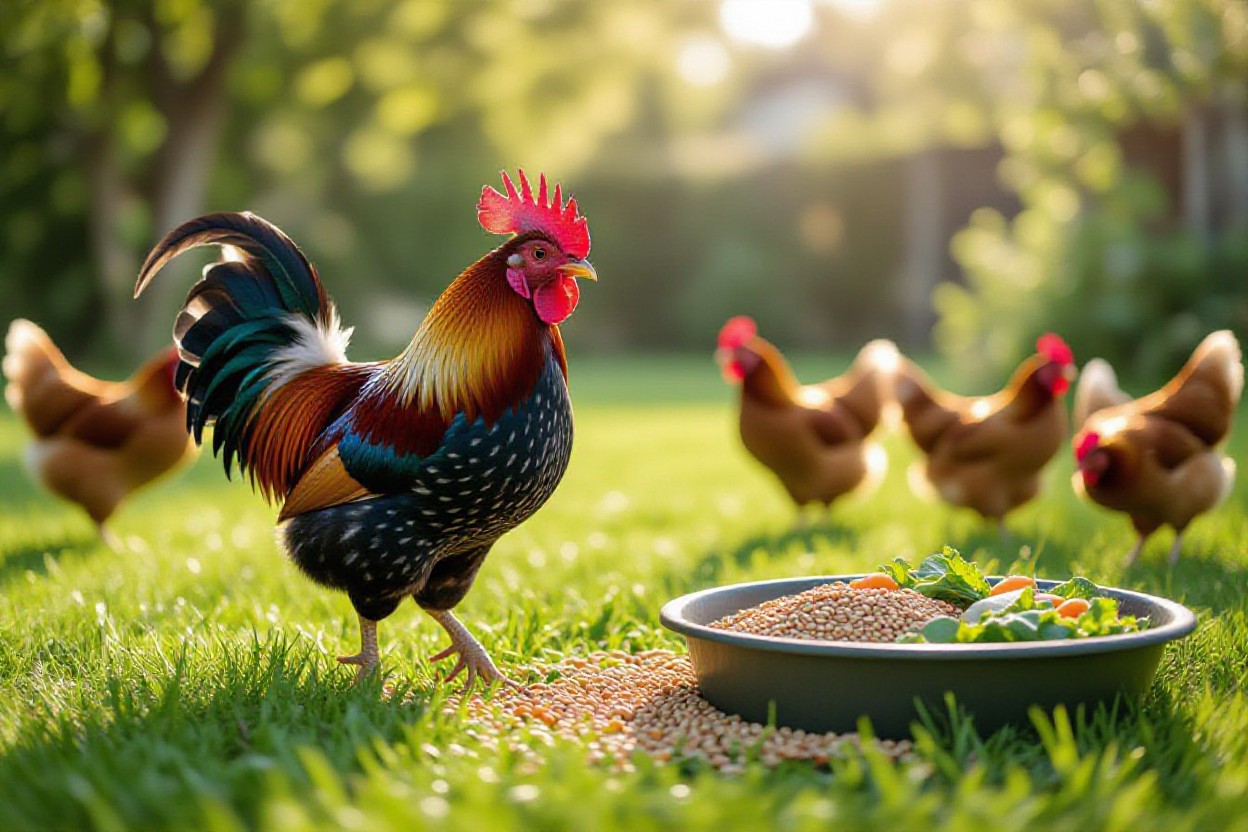
Nutrition Requirements
You should provide a balanced, predictable diet so your rooster maintains condition, fertility, and alert behavior. Aim for about 100–150 g (3.5–5.3 oz) of formulated feed per day for a standard adult rooster, plus access to fresh water and forage. Rotate feeds seasonally and avoid moldy grain or excessive treats, since mycotoxins and obesity are common, preventable threats to a healthy rooster.
Essential Nutrients
Feed formulations must supply adequate protein (generally 12–16% for maintenance, rising to 16–18% for active or breeding birds), balanced fats and carbohydrates, and vitamins A, D, E and B-complex. Minerals matter too: keep calcium moderate (~0.5–0.8%) because roosters do not need the high calcium used for laying hens, and maintain phosphorus and trace minerals to support bone and reproductive health. Also ensure continuous access to clean water for nutrient utilization.
Feeding Practices
Use pelleted or crumbled maintenance feed as the base, and provide it either free-choice in a hopper or in measured daily portions; both work if you monitor intake. For example, give about 100–150 g/day and limit kitchen scraps to under 10% of calories. Avoid feeding layer mash routinely because its high calcium can harm male kidneys and reproductive function.
For more detail, stagger feeding times to observe appetite and behavior, place feeders off the ground to cut waste, and supply grit if your birds lack access to natural grit from free-range foraging. You can supplement with greens, mealworms (10–20 g occasionally) or seed mixes as enrichment, but track weight and comb color to adjust rations. Rapid changes in feed should be phased over 7–10 days to prevent digestive upset; discard any suspect feed promptly to avoid toxicosis.
Common Health Issues
You’ll encounter parasites, respiratory infections, bumblefoot, reproductive problems and trauma most often; left untreated, respiratory distress, severe lameness or systemic infection can progress within 24–72 hours to emergency status. Observe your flock daily for changes in activity, comb color, feed intake and droppings to protect a healthy rooster and limit spread to hens.
Identification and Symptoms
Watch for lethargy, reduced crowing, ruffled feathers, weight loss and changes in droppings; nasal discharge, coughing, or noisy breathing signal respiratory disease. Also note swollen joints, limping or scabbed feet for bumblefoot, and pale or shrunken combs with low activity for systemic illness. If more than one bird shows the same sign, treat it as a contagious problem.
Treatment Options
Treatments include isolation, topical miticides and coop sanitation for external parasites, broad-spectrum anthelmintics for worms, and vet-prescribed antibiotics for bacterial respiratory or wound infections. Provide wound cleaning, soft bedding, heat and fluid/nutritional support while awaiting veterinary guidance to reduce mortality and speed recovery.
In practice, you’ll often repeat parasite treatments after 10–14 days and monitor antibiotic courses for 5–7 days per your vet’s plan; severe bumblefoot may need debridement and bandaging for 3–14 days. For example, cleaning and permethrin treatment plus coop overhaul eliminated a mite outbreak in a 12-bird flock within three weeks. Seek veterinary care if signs persist beyond 48 hours or if multiple birds are affected.

Preventive Care
Vaccination and Deworming
You should follow a targeted vaccine schedule—Marek’s vaccine at day-old is common, with Newcastle, infectious bronchitis and fowl pox vaccines given at hatchery or 4–6 weeks and boosters annually as needed. Use fecal egg counts every 3–6 months to guide worm control; many keepers deworm based on results rather than routine dosing. Heavy roundworm or gapeworm loads cause weight loss and poor fertility, so treat promptly under veterinary guidance and document outcomes.
Environmental Management
Keep your coop dry, well-ventilated and predator-proof: provide roughly 4 sq ft per bird inside and 8–10 sq ft in the run, clean bedding weekly or use deep-litter with scheduled turnover, and maintain ammonia below 10 ppm to prevent respiratory disease. Use nipple drinkers to cut water spillage, seal gaps against rodents, and quarantine newcomers for 2 weeks to limit pathogen entry—these steps directly lower common illness rates in a healthy rooster flock.
Improve pasture rotation by moving the flock every 2–4 weeks to break parasite cycles, add gravel or raised concrete aprons at pop-holes for drainage, and sanitize feeders weekly. Apply a 1:10 bleach solution for heavy contamination or registered poultry disinfectants following label instructions; after cleaning, allow full drying and 24–48 hours before reintroduction. These practical measures reduce parasite burden, cut bacterial loads, and boost overall resilience in your healthy rooster population.
FAQs
Quick answers
If you check your flock for 5–10 minutes daily, you’ll spot issues early; a healthy rooster shows a bright red comb, active feeding, and clear eyes. Also note normal temperature is about 40.6–41.7°C (105–107°F)</strong) and rapid breathing over 40 breaths/min or labored breathing signals trouble. In practice, seek veterinary care for fever >42°C (107.6°F), pale comb, swollen joints, or lethargy lasting over 24 hours.
Summing up
Taking this into account, maintaining a healthy rooster relies on daily observation of bright eyes, alert behavior, good appetite, clean vents and firm droppings, balanced nutrition, and safe housing; you should schedule preventive care and prompt veterinary attention for any changes, monitor aging and breeding soundness, and address common issues early to preserve flock productivity and welfare. With routine checks and decisive action, you keep your rooster fit and your operation resilient.
